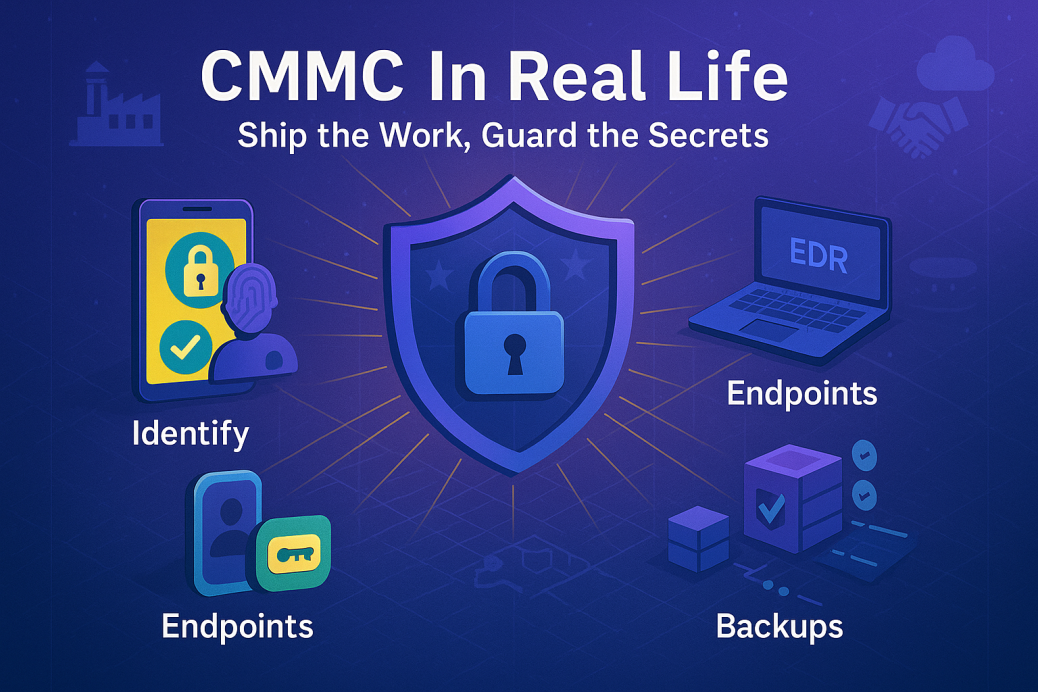Defense work is supposed to be about building useful things and delivering them on time. Lately it can feel like a scavenger hunt through acronyms. CMMC sits at the center of that feeling. It is not a new universe of rules. It is the Department of Defense asking every contractor to prove they can protect controlled data and keep the chain of custody intact. Said plainly, do the work and keep secrets.
What CMMC actually is
CMMC is a way to verify that the security controls you say you have are the ones you actually use. It groups expectations into levels. Level 1 covers basic safeguarding for Federal Contract Information. Level 2 maps to the set of practices used to protect Controlled Unclassified Information. Level 3 adds enhanced measures for programs that need extra assurance.
The big idea is not the labels. It is the timing. Proof is needed before and during performance, not after an incident. Your story must make sense in real life, not just in a policy binder.
Why it matters to the business side
CMMC is a gate. Contract awards and option years depend on it. Prime contractors care because the rules flow down to their supply chains. Small shops care because a single weak link can put a prime at risk. Insurance, financing, and due diligence conversations all get easier when your security story is coherent and tested.
Where the sharp edges live
Scope that wanders. CUI should live where it needs to live and nowhere else. If you scatter it across laptops, cloud drives, and email, your compliance costs grow with every copy. Pick a clean boundary and defend it.
Policies that do not match the floor. Auditors read what you wrote and then watch what people do. If your team bypasses a control to get work done, the control is wrong or the process is wrong. Fix it in the workflow, not just in the document.
Vendors you forgot to treat as insiders. Cloud suites, file transfer tools, and managed services are part of your system. You must be able to explain how each one handles your data and which controls they cover. Contracts should reflect that reality.
Evidence that is thin. A control without proof is a wish. Screenshots, config exports, tickets, and logs are what make your story solid. Keep them tidy and current.
What success looks like from the outside
A successful CMMC program is quiet. Identity is strong and boring. Endpoints are managed and predictable. Backups restore because someone tries it often. Logs answer simple questions without a scavenger hunt. Your staff can explain where CUI lives and how it moves. When a customer asks for proof, you send a small, organized set of files and nobody needs a follow up call.
A practical way to move forward without stopping the line
Start with the thing you actually sell. Map how the work happens from quote to delivery and mark the places where CUI appears. Choose the smallest reasonable enclave for that data. Build guardrails that let people get work done inside that boundary and make it hard to leak data outside it. Close gaps one control family at a time. Identity and access come first. Then endpoint protection and patching. Then logging and backup. Train the team using the tools they already open each day. Keep leadership in the loop with short, plain updates that tie progress to contract risk and revenue.
The everyday controls that carry the weight
You do not need to reinvent the craft. Multi factor authentication on privileged access and remote entry. Managed devices with current updates. Encryption on the move and at rest. Role based access that shrinks when people change jobs. Email and web filtering that blocks what should never arrive. Backups that exist in more than one place and pass a restore test. Alerts that reach a human who knows what to do in the first hour. All of this is normal work. CMMC asks you to prove it is normal at your shop.
Where Affant fits
Affant helps teams draw the boundary, pick the right controls, and collect the evidence that shows the system works any day of the week. We focus on the parts that move risk the most, calm the vendor tangle, and keep the paperwork aligned with real workflows. Some clients need a light touch. Others want deeper help with identity, endpoints, logging, and recovery. We match the pace to your contracts and deliverables and leave you with artifacts that speak for themselves.











